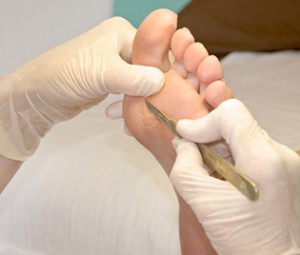Corns and calluses are areas of hard, thickened skin that develop when the skin is exposed to excessive pressure or friction. They commonly occur on the feet and can cause pain and discomfort when you walk.
 Corns
Corns
Corns are areas of thick skin that usually develop on the tops and sides of toes or on the sole of the foot. However,
they can occur anywhere.
Corns are often caused by:
- wearing poorly fitting shoes
- shoe designs that place excessive pressure on an area of the foot – for example, high-heeled shoes can squeeze the toes.
Corns often occur on bony feet as there’s a lack of natural cushioning. They can also develop as a symptom of another foot problem, such as:
- hammer toe – where the toe is bent at the middle joint or
- a bunion – where the joint of the big toe sticks outwards as the big toe begins to point towards the other toes on the same foot
A hard corn is a small patch of thickened, dead skin with a small plug of skin in the centre. A soft corn has a much thinner surface, appears whitish and rubbery, and usually occurs between the toes Seed corns are clusters of tiny corns which tend to occur on the bottom of the feet which can be very tender if they are on a weight-bearing part of the foot. Neurovascular corns can be very problematic for the patient. These corns have nerves and vessels wrapped around them which can bleed easily and are painful.
Calluses
Calluses are hard, rough areas of skin that are often yellowish in colour.
Calluses are larger than corns and don’t have such a well-defined edge. It is often less sensitive to touch than the surrounding skin as callused skin is thick.
They often form over the ball of your foot because this area takes most of your weight when you walk and they develop when the skin rubs against something, such as a bone, a shoe or the ground.
Athletes are particularly susceptible to them as they put repeated pressure on the foot when running.
Other possible causes of calluses include:
- dry skin
- reduced fatty padding – elderly people have less fatty tissue in their skin
- regularly holding objects such as a hammer or racquet
Treating corns and calluses
If you have a corn on your foot, you should rather see a professional who can advise you on an underlying problem and treat it for you.
Corns on feet won’t get better unless the cause of the pressure is removed. If the cause isn’t removed, the skin could become thicker and more painful over time.
The use of an acid which numbs the nerves may be needed for the removal of a neurovascular corn as it helps to reduce the vessels to the area.
Over-the-counter treatments for corns, such as corn plasters, are available, however, they don’t treat the cause of the corn and may affect the normal, thinner skin surrounding the corn which may not be at all suitable for certain people with circulation problems, such as those with diabetes or fragile skin.
 Calluses
Calluses
As with corns, you should only treat calluses yourself after a foot professional has identified the cause and advised you about treatment.
A sharp blade might be needed to remove badly callused areas to remove the thickened area of skin. This is painless and should help reduce pain and discomfort.
Advice on footwear and insoles will be given by your Practitioner. It is advisable NOT to treat corns and calluses by yourself.

